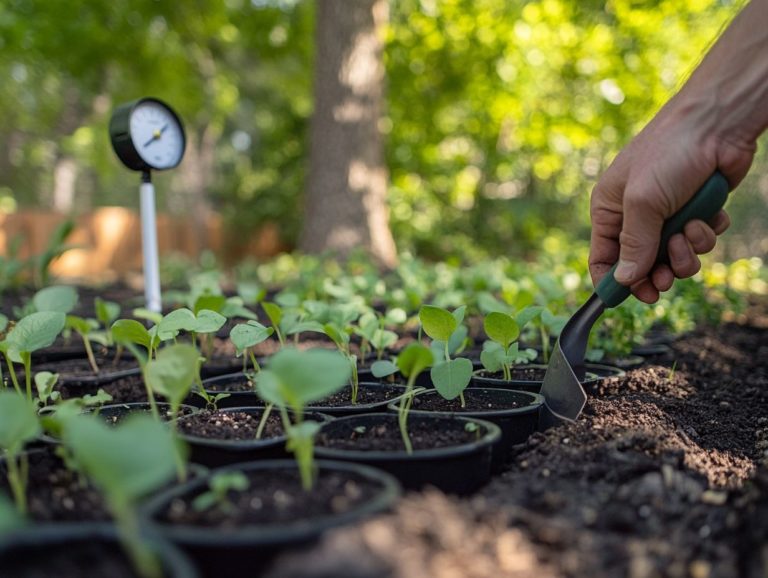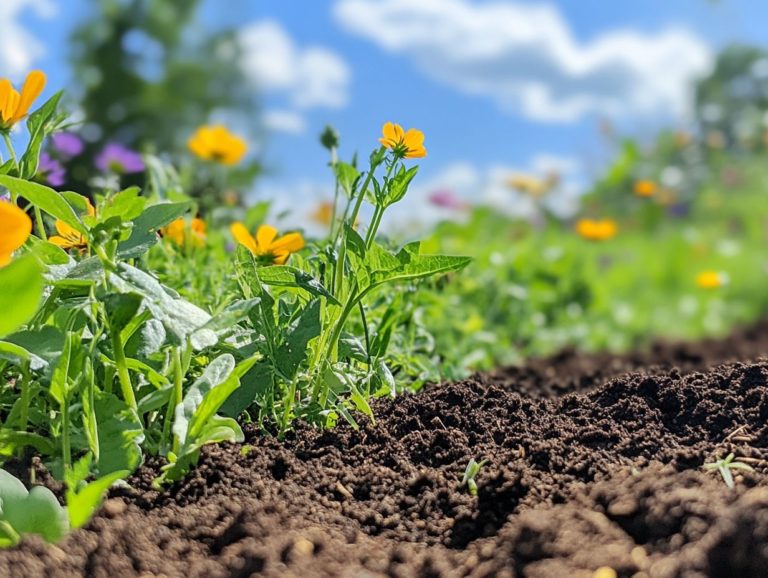Essential Nutrients for Drought Plants
Drought-resistant plants are extraordinary survivors, adept at thriving in challenging environments where water is hard to come by.
Understanding these resilient species is vital, particularly regarding their nutritional needs. This article explores the essential nutrients that enhance drought tolerance, highlights signs of nutrient deficiencies, and presents effective fertilization techniques.
By maximizing nutrient absorption and optimizing soil conditions, you can ensure that your drought-resistant plants not only survive but truly flourish, even in the harshest conditions.
Get ready to unlock powerful tips that will help your plants thrive!
Contents
- Key Takeaways:
- Understanding Drought-Resistant Plants
- The Importance of Essential Nutrients for Drought-Resistant Plants
- Key Nutrients for Drought-Resistant Plants
- Signs of Nutrient Deficiency in Drought Plants
- How to Provide Essential Nutrients to Drought Plants
- Maximizing Nutrient Absorption in Drought Plants
- Frequently Asked Questions
- What are key nutrients for drought plants?
- Why are key nutrients important for drought plants?
- What are some common key nutrients for drought plants?
- How do drought plants obtain key nutrients?
- What happens if drought plants lack key nutrients?
- Can key nutrients help drought plants become more drought-resistant?
Key Takeaways:

- Drought-resistant plants need essential nutrients to survive and thrive in harsh conditions.
- Key nutrients such as nitrogen, phosphorus, and potassium play a crucial role in drought tolerance.
- Effective fertilization techniques and optimizing soil and water conditions are key to maximizing nutrient absorption.
Understanding Drought-Resistant Plants
Understanding drought-resistant plants requires exploring their unique adaptations and survival needs in arid conditions. These remarkable species thrive in harsh environments thanks to specialized mechanisms that allow them to efficiently utilize essential nutrients like nitrogen, phosphorus, and potassium.
By grasping their biology and nutrient requirements, you can cultivate healthier soil and enhance crop yields through effective nutrient management practices. This knowledge is vital for agricultural education and innovation, particularly in regions susceptible to drought, where resource conservation is paramount.
What are Drought-Resistant Plants?
Drought-resistant plants are fascinating species that have evolved unique adaptations to flourish in water-scarce environments.
These remarkable organisms showcase various survival strategies, including deep root systems that tap into subterranean water sources and thick, waxy leaves designed to minimize moisture loss. Often, they feature distinctive leaf shapes and sizes, crucial for reducing transpiration and conserving precious water. Nutrient requirements are also essential for their resilience; for instance, essential nutrients like potassium and phosphorus bolster their cellular structure and enhance drought resistance.
Through these impressive adaptations, drought-resistant plants not only survive but also play a vital role in their ecosystems, preventing soil erosion and providing habitats for diverse wildlife.
The Importance of Essential Nutrients for Drought-Resistant Plants
Essential nutrients are crucial for drought-resistant plants, significantly enhancing their tolerance to dry conditions and promoting overall health. Understanding why drought-resistant plants are essential today can further emphasize their importance in sustainable gardening.
When these plants receive the right nutrients, they can better withstand environmental stressors and thrive in challenging climates.
The Role of Nutrients in Drought Tolerance
Nutrients are vital in bolstering drought tolerance, supporting the production of chlorophyll, and ensuring efficient nutrient uptake.
By providing your plants with adequate levels of essential elements like nitrogen, magnesium, and iron, you can optimize the process plants use to make their food. This enhancement allows photosynthesis to thrive, even under water-stressed conditions. Achieving the right nutrient balance promotes robust root development, enabling better absorption of both water and nutrients.
When your plants are well-nourished, they demonstrate improved physiological functions and resilience against drought stress.
Implementing effective nutrient management strategies, such as proper fertilization and soil amendments, can significantly elevate overall plant health, allowing them to withstand challenging climatic conditions with remarkable ease.
Key Nutrients for Drought-Resistant Plants

Key nutrients such as nitrogen, phosphorus, potassium, and magnesium are vital for the growth and resilience of drought plants.
By ensuring these nutrients are present, you can significantly enhance the health and sustainability of your garden in challenging conditions.
Start enriching your soil today!
Types and Functions of Essential Nutrients
Essential nutrients are divided into macronutrients and micronutrients. Each plays a vital role in your plants’ health and development.
Macronutrients include nitrogen, phosphorus, and potassium. These nutrients are critical for vibrant growth and plant vitality.
Nitrogen is essential for leaf development and overall vegetative growth. Phosphorus bolsters strong root systems and aids in flowering, ensuring effective reproduction. Meanwhile, potassium boosts disease resistance and helps regulate water.
Lacking these key nutrients leads to stunted growth and poor yields. Plants also become more vulnerable to pests and diseases. This highlights the necessity of maintaining balanced nutrient levels in your soil.
Healthy soil, rich in these essential nutrients, fosters optimal plant growth, nurtures a thriving ecosystem, and leads to bountiful harvests.
Signs of Nutrient Deficiency in Drought Plants
Watch for signs of nutrient deficiency in drought-stricken plants. Early detection is crucial for restoring their health! Symptoms include stunted growth, leaf discoloration, and inadequate flowering.
Identifying and Addressing Deficiencies
Identifying nutrient deficiencies requires you to assess plant symptoms and conduct soil testing to determine nutrient availability.
Healthy plants often display noticeable signs when they lack certain nutrients think yellowing leaves or stunted growth. Observing these symptoms provides valuable insights, signaling that it’s time to dig a little deeper.
Conducting soil tests uncovers the nutrient composition effectively. This dual approach allows you to pinpoint deficiencies with precision.
Once you identify the gaps, address them by incorporating organic amendments such as compost or specific nutrient sources designed to rectify those deficits. These strategies significantly enhance both soil health and plant vitality.
How to Provide Essential Nutrients to Drought Plants
To ensure that drought-plagued plants receive the essential nutrients they need, engage in thoughtfully planned fertilizer applications.
Selecting the right balanced fertilizer tailored to the specific nutrient composition will make all the difference in nurturing those resilient plants back to health.
Effective Fertilization Techniques

Effective fertilization techniques are essential for optimizing nutrient uptake and enhancing the health of drought-resistant plants.
By integrating a blend of organic matter, timing your applications strategically, and employing methods like foliar feeding, you can significantly boost the resilience and yield of your crops.
Incorporating organic materials such as compost or well-rotted manure enriches soil structure and improves its water retention capabilities, making nutrients more readily accessible to your plants.
Embracing best agricultural practices, including crop rotation and cover cropping, further enhances soil fertility and microbial activity. These practices foster sustainable growth, even in arid conditions.
These combined approaches contribute to a healthier plant ecosystem, ensuring that your crops remain robust and productive, even in the face of water scarcity.
Maximizing Nutrient Absorption in Drought Plants
To maximize nutrient absorption in drought-resistant plants, grasp the intricacies of soil texture, the availability of nutrients, and the ideal water conditions. Understanding these elements is crucial for fostering robust growth in challenging environments.
Optimizing Soil and Water Conditions
Optimizing soil and water conditions is vital for ensuring that nutrients are readily available and supporting the root hairs of drought-tolerant plants.
The relationship between a healthy soil structure and how we manage water in the soil is essential for promoting deep root growth. This growth significantly enhances nutrient absorption.
When the soil is well-aerated and crumbly, it allows water to seep through consistently. This creates an environment where roots can expand without restriction. This improved structure retains moisture and encourages helpful tiny organisms in the soil, converting nutrients into more accessible forms for the plants.
Managing the soil-water relationship effectively supports plant health. This helps them thrive even in tough conditions.
Frequently Asked Questions
What are key nutrients for drought plants?
Key nutrients for drought plants are specific minerals and compounds necessary for their growth and survival, especially during periods of limited water availability. Utilizing the right essential tools for drought garden care can make a significant difference in their health.
Why are key nutrients important for drought plants?

During drought conditions, plants may have difficulty absorbing water and other key minerals from the soil. Therefore, having a sufficient supply of key nutrients is crucial for their survival and ability to thrive, along with utilizing the top tools for caring for drought plants.
What are some common key nutrients for drought plants?
- Nitrogen
- Phosphorus
- Potassium
- Calcium
- Magnesium
- Sulfur
These nutrients play important roles in various plant processes, such as photosynthesis, root development, and water regulation.
How do drought plants obtain key nutrients?
Drought plants eagerly soak up key nutrients through their root systems, which absorb water and minerals from the soil. They can also absorb nutrients through their leaves, a process known as foliar feeding, although this method may be less effective during drought conditions.
What happens if drought plants lack key nutrients?
If drought plants lack key nutrients, they may experience stunted growth, reduced flowering and fruit production, and increased susceptibility to diseases and pests. In severe cases, the plants may even die.
Can key nutrients help drought plants become more drought-resistant?
Yes, supplying drought plants with sufficient key nutrients can help increase their drought tolerance. These nutrients support the plant’s ability to withstand water stress and maintain proper functioning, even during periods of limited water availability.
To learn more about drought gardening techniques or to get involved in local gardening communities, explore resources available to you!






